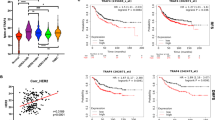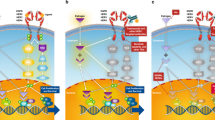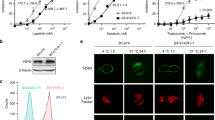Abstract
Treatment with tyrosine kinase inhibitors (TKIs) including trastuzumab has revolutionized the management of HER2-positive breast cancer. Recent evaluation of clinical trial data suggests that a subset of HER2/ER double-positive cancers may not receive significant benefit from the TKI therapy. Here we investigate the cross talk between HER2 and ER in breast cancer and monitor the effect of trastuzumab on the tyrosine kinase effector transcription factor Myc. In HER2-positive breast cancer patients treated with neoadjuvant trastuzumab, steroid receptor-negative status (ER and PR negative) of pre-treatment biopsies predicted pathological complete response (pCR) (n=31 patients, P=0.0486), whereas elevated Myc protein inversely associated with pCR (P=0.0446). Liquid chromatography mass spectrometry identified the corepressor SMRT as a novel Myc-interacting protein. Trastuzumab treatment enhanced Myc–SMRT interactions in HER2-overexpressing breast cancer cells (LCC1) and inhibited expression of the Myc target gene survivin. In HER2-low, ER-positive steroid-dominant cells (MCF7), trastuzumab therapy repressed Myc–SMRT interactions and upregulated survivin expression. Trastuzumab treatment induced ER–CBP interactions, enhanced ER transcriptional activity and upregulated expression of the ER target gene pS2. The absence of pS2 expression in pre-treatment biopsies predicted pCR to neoadjuvant trastuzumab in breast cancer patients (n=25, P=0.0089) and pS2 expression associated with residual cancer burden (P=0.0196). Furthermore, metastatic tissues from patients who had failed trastuzumab therapy were pS2 positive. In HER2-overexpressing cells, trastuzumab treatment can repress Myc transcriptional activity and clinical response is favorable. However, with co-expression of the steroid pathway, this inhibition is lost and response to treatment is often poor.
This is a preview of subscription content, access via your institution
Access options
Subscribe to this journal
Receive 50 print issues and online access
$259.00 per year
only $5.18 per issue
Buy this article
- Purchase on Springer Link
- Instant access to full article PDF
Prices may be subject to local taxes which are calculated during checkout



Similar content being viewed by others
References
Osborne CK, Schiff R . Mechanisms of endocrine resistance in breast cancer. Annu Rev Med 2011; 62: 233–247.
McBryan J, Theissen SM, Byrne C, Hughes E, Cocchiglia S, Sande S et al. Metastatic progression with resistance to aromatase inhibitors is driven by the steroid receptor coactivator SRC-1. Cancer Res 2012; 72: 548–559.
Leary AF, Drury S, Detre S, Pancholi S, Lykkesfeldt AE, Martin LA et al. Lapatinib restores hormone sensitivity with differential effects on estrogen receptor signaling in cell models of human epidermal growth factor receptor 2-negative breast cancer with acquired endocrine resistance. Clin Cancer Res 2010; 16: 1486–1497.
Massarweh S, Osborne CK, Creighton CJ, Qin L, Tsimelzon A, Huang S et al. Tamoxifen resistance in breast tumors is driven by growth factor receptor signaling with repression of classic estrogen receptor genomic function. Cancer Res 2008; 68: 826–833.
Baselga J, Bradbury I, Eidtmann H, Di Cosimo S, de Azambuja E, Aura C et al. Lapatinib with trastuzumab for HER2-positive early breast cancer (NeoALTTO): a randomised, open-label, multicentre, phase 3 trial. Lancet 2012; 379: 633–640.
Guarneri V, Frassoldati A, Bottini A, Cagossi K, Bisagni G, Sarti S et al. Preoperative chemotherapy plus trastuzumab, lapatinib, or both in human epidermal growth factor receptor 2-positive operable breast cancer: results of the randomized phase II CHER-LOB study. J Clin Oncol 2012; 30: 1989–1995.
Nahta R, O'Regan RM . Therapeutic implications of estrogen receptor signaling in HER2-positive breast cancers. Breast Cancer Res Treat 2012; 135: 39–48.
Pinzone JJ, Stevenson H, Strobl JS, Berg PE . Molecular and cellular determinants of estrogen receptor alpha expression. Mol Cell Biol 2004; 24: 4605–4612.
Adams BD, Cowee DM, White BA . The role of miR-206 in the epidermal growth factor (EGF) induced repression of estrogen receptor-alpha (ERalpha) signaling and a luminal phenotype in MCF-7 breast cancer cells. Mol Endocrinol 2009; 23: 1215–1230.
Stoica A, Saceda M, Doraiswamy VL, Coleman C, Martin MB . Regulation of estrogen receptor-alpha gene expression by epidermal growth factor. J Endocrinol 2000; 165: 371–378.
Sabnis G, Schayowitz A, Goloubeva O, Macedo L, Brodie A . Trastuzumab reverses letrozole resistance and amplifies the sensitivity of breast cancer cells to estrogen. Cancer Res 2009; 69: 1416–1428.
Peck B, Ferber EC, Schulze A . Antagonism between FOXO and MYC Regulates Cellular Powerhouse. Front Oncol 2013; 3: 96.
Xia W, Bacus S, Hegde P, Husain I, Strum J, Liu L et al. A model of acquired autoresistance to a potent ErbB2 tyrosine kinase inhibitor and a therapeutic strategy to prevent its onset in breast cancer. Proc Natl Acad Sci USA 2006; 103: 7795–7800.
Chen FL, Xia W, Spector NL . Acquired resistance to small molecule ErbB2 tyrosine kinase inhibitors. Clin Cancer Res 2008; 14: 6730–6734.
Kim C . Trastuzumab sensitivity of breast cancer with co-amplification of HER2 and cMYC suggests pro-apoptotic function of dysregulated cMYC in vivo. In: Breast Cancer Research and Treatment, vol. 94. Springer: New York, NY, USA, 2005, pp S6–S7.
Perez EA, Jenkins RB, Dueck AC, Wiktor AE, Bedroske PP, Anderson SK et al. C-MYC alterations and association with patient outcome in early-stage HER2-positive breast cancer from the north central cancer treatment group N9831 adjuvant trastuzumab trial. J Clin Oncol 2011; 29: 651–659.
Brennan K, McSherry EA, Hudson L, Kay EW, Hill AD, Young LS et al. Junctional adhesion molecule-A is co-expressed with HER2 in breast tumors and acts as a novel regulator of HER2 protein degradation and signaling. Oncogene 2013; 32: 2799–2804.
Chen JD, Umesono K, Evans RM . SMRT isoforms mediate repression and anti-repression of nuclear receptor heterodimers. Proc Natl Acad Sci USA 1996; 93: 7567–7571.
Nagy L, Kao HY, Chakravarti D, Lin RJ, Hassig CA, Ayer DE et al. Nuclear receptor repression mediated by a complex containing SMRT, mSin3A, and histone deacetylase. Cell 1997; 89: 373–380.
Sanchez-Arévalo Lobo VJ, Doni M, Verrecchia A, Sanulli S, Fagà G, Piontini A et al. Dual regulation of Myc by Abl. Oncogene 2013; 45: 5261–5271.
Sankar N, Baluchamy S, Kadeppagari RK, Singhal G, Weitzman S, Thimmapaya B . p300 provides a corepressor function by cooperating with YY1 and HDAC3 to repress c-Myc. Oncogene 2008; 27: 5717–5728.
Cosgrave N, Hill AD, Young LS . Growth factor-dependent regulation of survivin by c-myc in human breast cancer. J Mol Endocrinol 2006; 37: 377–390.
Rexer BN, Arteaga CL . Intrinsic and acquired resistance to HER2-targeted therapies in HER2 gene-amplified breast cancer: mechanisms and clinical implications. Crit Rev Oncog 2012; 17: 1–16.
Chakrabarty A, Bhola NE, Sutton C, Ghosh R, Kuba MG, Dave B et al. Trastuzumab-resistant cells rely on a HER2-PI3K-FoxO-survivin axis and are sensitive to PI3K inhibitors. Cancer Res 2013; 73: 1190–1200.
Coombes RC, Tat T, Miller ML, Reise JA, Mansi JL, Hadjiminas DJ et al. An open-label study of lapatinib in women with HER-2-negative early breast cancer: the lapatinib pre-surgical study (LPS study). Ann Oncol 2013; 24: 924–930.
Junttila TT, Akita RW, Parsons K, Fields C, Lewis Phillips GD, Friedman LS et al. Ligand-independent HER2/HER3/PI3K complex is disrupted by trastuzumab and is effectively inhibited by the PI3K inhibitor GDC-0941. Cancer Cell 2009; 15: 429–440.
Acknowledgements
We thank Lance Hudson for his technical expertise and thank Dr Robert Clarke, Georgetown, Washington, for his kind gift of the LCC1 cells. We kindly acknowledge the funding support from Science Foundation Ireland (08-IN1-B1853) and the Health Research Board of Ireland (HRB/POR/2012/101). This material is also based on works supported by the Irish Cancer Society Collaborative Cancer Research Centre grant, CCRC13GAL.
Author information
Authors and Affiliations
Corresponding author
Ethics declarations
Competing interests
The authors declare no conflict of interest.
Additional information
Supplementary Information accompanies this paper on the Oncogene website
Rights and permissions
About this article
Cite this article
Collins, D., Cocchiglia, S., Tibbitts, P. et al. Growth factor receptor/steroid receptor cross talk in trastuzumab-treated breast cancer. Oncogene 34, 525–530 (2015). https://doi.org/10.1038/onc.2013.586
Received:
Revised:
Accepted:
Published:
Issue Date:
DOI: https://doi.org/10.1038/onc.2013.586
Keywords
This article is cited by
-
Pyrotinib in combination with letrozole for hormone receptor-positive, human epidermal growth factor receptor 2-positive metastatic breast cancer (PLEHERM): a multicenter, single-arm, phase II trial
BMC Medicine (2023)
-
A small-molecule inhibitor of SMAD3 attenuates resistance to anti-HER2 drugs in HER2-positive breast cancer cells
Breast Cancer Research and Treatment (2017)
-
MiR-16 mediates trastuzumab and lapatinib response in ErbB-2-positive breast and gastric cancer via its novel targets CCNJ and FUBP1
Oncogene (2016)



